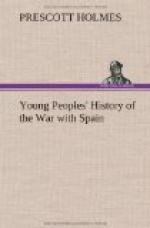He had done such things as to rescue seven men who were starving to death in the Arctic regions. He had been sent by the Government to do this, and, realizing that it must be done quickly, he pushed on so fast that he found the seven men alive. If he had been slower in his movements they would have been dead, for they were in the last stages of starvation and exhaustion. At another time, some of his sailors were stoned in the city of Valparaiso, and one of them was killed. Schley trained his guns upon the city and kept them there until the murderers were given up to justice. He was the right kind of a man to have around the coasts of Cuba, wasn’t he?
[Illustration: Rear-Admiral W.S. Schley.]
Now I am going to tell you the names of the Spanish vessels, and give you an idea of the blockade.
Within the harbor were four large Spanish ships and two new, fast torpedo-boat destroyers, all commanded by Admiral Cervera. The ships were the Infanta Maria Teresa, named for a Spanish princess; the Vizcaya, named for a province in Spain; the Cristobol Colon, which is the Spanish name for Christopher Columbus; and the Almirante Oquendo. Many years ago Spain had a famous admiral whose name was Oquendo, and in recognition of his services the Spanish Government made a law that there should always be a ship in their navy bearing his name. That is how they had the Almirante Oquendo, which means Admiral Oquendo. The names of the torpedo-boat destroyers were the Furor and the Pluton. All these warships were splendid vessels, and were commanded by brave men. We shall hear about them later.
Our ships were outside the harbor—a few miles from its mouth, in a line like a half-circle. Our big ships were the New York, the Brooklyn, the Texas, the Iowa, the Oregon, the Indiana, and the Massachusetts. There were a number of smaller vessels, and one of them, the Gloucester, afterwards gained great fame. Our ships could not anchor, as the water was too deep, so they were always moving back and forth.
As I have told you, between the sea and the harbor, or bay, is a long, narrow channel with high cliffs on each side, and on these cliffs are forts, which guard the entrance to the harbor.
Our men could not see the Spanish ships in the harbor, but could see only the narrow channel and the hills and forts above it. Our men watched carefully, to see that no Spanish ship came out. For the first few nights of the blockade a bright moon lighted up the channel, but after the moon failed, the place was wonderfully lighted by the great “search-lights” of our ships. Four battleships took turns of two hours each in standing at the entrance of the channel and moving the “searchlights.” The ships were always headed toward the shore, and steam was kept up.
And so our great gray vessels, grim monsters of the sea, waited and watched near the harbor of Santiago de Cuba.




